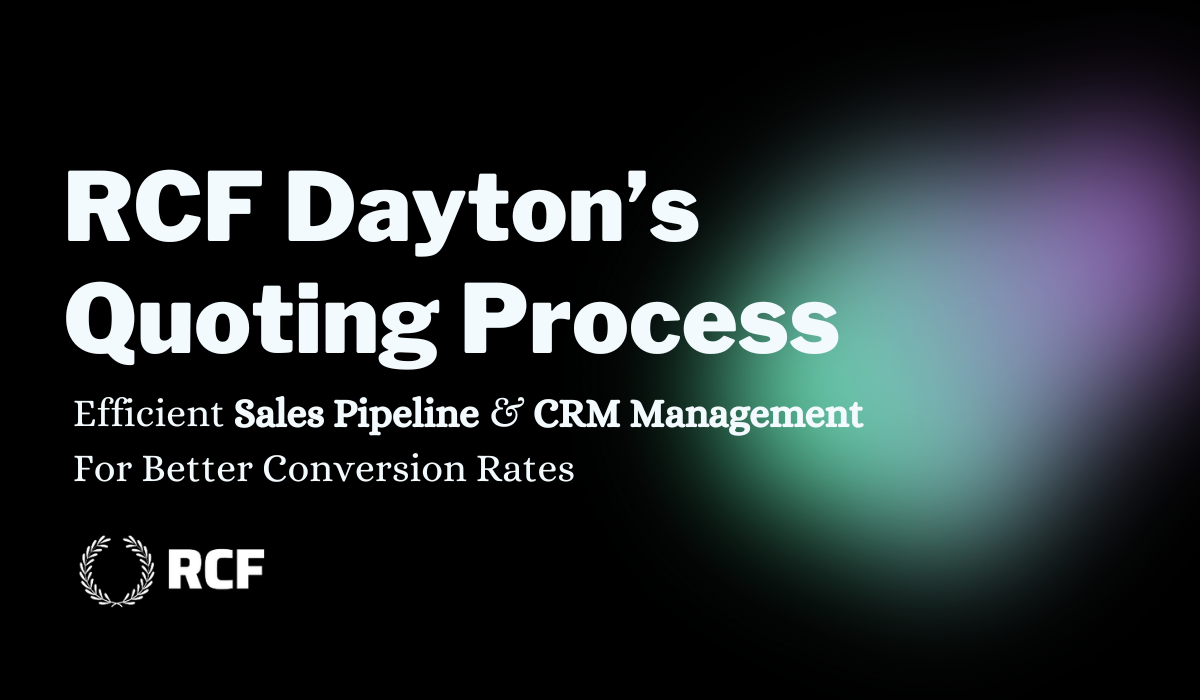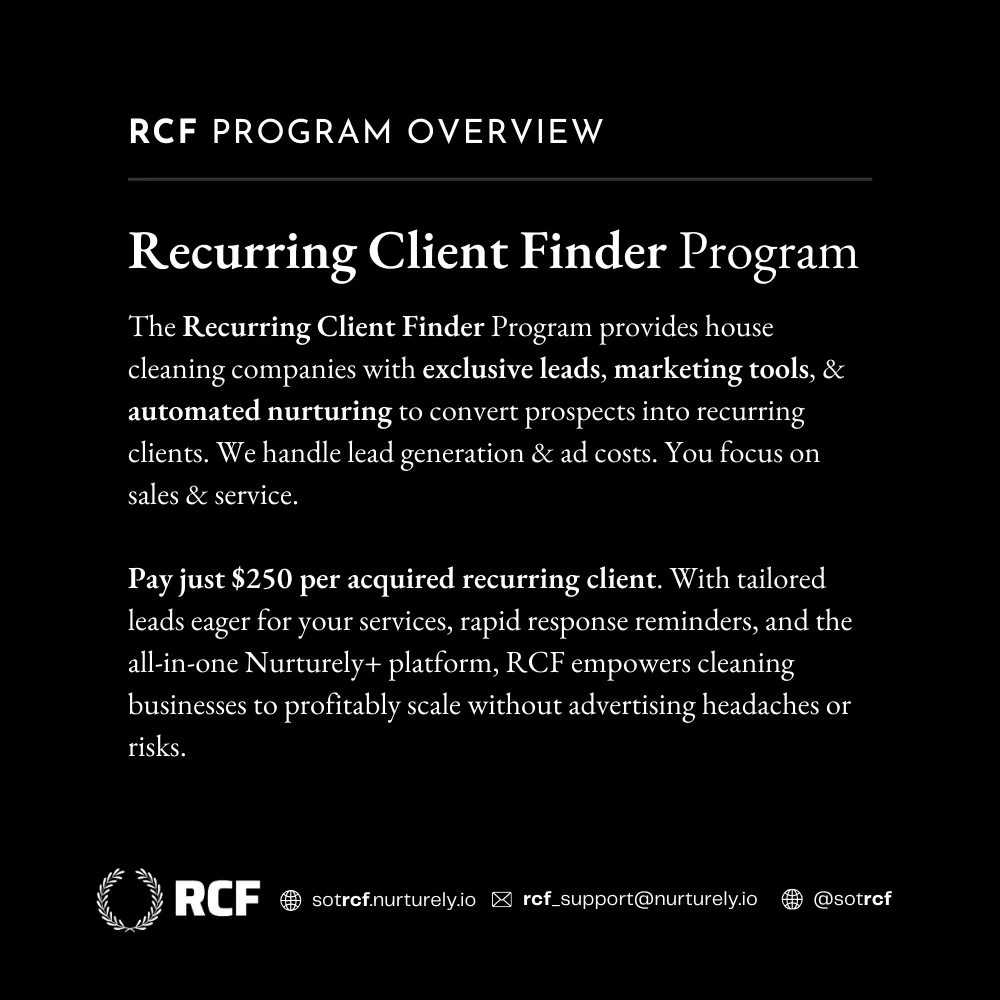
RCF Dayton’s Quoting Process
Streamlining the Quoting Process for Cleaning Services
Quoting for cleaning services can be quite a meticulous process.
However, with the right approach and tools, it becomes much more manageable, and having the right strategy you to win more clients. 🙂
Here’s a comprehensive guide based on a successful quoting process:
Step 1: New Leads Coming In
When a new lead comes in, it’s essential to get a hold of them right away.
You really need to think about what you are going to say, the information you need, and what approach you are going to take. Think about the core foundation you need and truly simplify it down as much as possible.
Our approach is to gather information, ask questions as needed, and send the estimate after the call in order to take pressure off the clients and the salespeople. The magic sauce for us is to have a sound follow up plan.
The main questions we need answered are:
1. What is your current challenge when it comes to cleaning?
2. What rooms do we need to clean?
3. What are the things you really want us to focus on?
4. What is your availability?
Step 2: Transcribing & Organizing Call Data
Once you've contacted the lead, record and transcribe the call. This transcription should summarize critical details such as the client's specific cleaning needs, rooms to be cleaned, and any special requests.
For instance, noting the square footage and preferred cleaning times is crucial for preparing an accurate quote. The Gem City Cleaning Tool will allow you to transcribe the calls and get the summaries based on your preferences and calling strategies. And this will be available soon through The RCF.
Being able to transcribe calls and get detailed notes not only shows a professional look to your customer, giving amazing notes to your cleaners to get the job done right, but you are also saving yourself time and it allows for the highest accuracy.
Step 3: Automating Information Transfer
After gathering all necessary information, use an automated system to transfer these details into your quoting software from your CRM with a tool like Zapier.
Automation reduces manual entry errors and speeds up the process. While the system provides an initial quote, always review and adjust it based on specific client needs and circumstances. This honestly is a huge life savor. With the amount of quotes we do a day, this probably saves us at least an hour - but not only does it transfer to our quoting system, it also transfers the client data to our scheduling system and our invoicing software as well.
Step 4: Customizing the Quote
Review the automatically generated quote to ensure accuracy. Adjust the price based on factors like the client's location, home size, and specific cleaning requirements.
For example, if the base rate is $150, but due to the small size and specific services, you might adjust it to $125. Add as much detail based on the information that the client provided you during the quote.
Additionally, we also use AI to help us take our current client data, stack up the prospect data and compare homes for how long it might take us to clean. This helps us double check ourselves to really ensure that we are not losing money here, and allows us to gain potential insight on future sales and profit we may have.
Step 5: Including Additional Information
Attach relevant documents like a cleaning checklist and company information to the quote. This transparency helps clients understand the services they’re paying for and builds trust. Your checklist might include details about your core values, services offered, and specific tasks performed in each room.
Step 6: Delivering the Estimate
Send the finalized quote to the client and tag it appropriately in your system. This triggers an automation that follows up with the client through a series of personalized text messages, ensuring they receive and review the quote.
Step 7: Follow-Up Automation
Automation is key to effective follow-up. Set up a series of text messages that:
Confirm the client received the quote.
Check if the quote meets their expectations.
Prompt a response if no action has been taken.
Allows for you to continuously stay in contact with your leads.
Helps you get them out of the pipeline faster.
Effective Follow-Up Example:
“Hi Yvette, this is Chris from Gem City Cleaning Crew. I sent the quote over to you a couple of days ago and haven’t heard back from you. Are you still looking for a cleaner? Here is the link to the quote for your reference.”
Step 8: Handling Non-Responses
If a client doesn’t respond, send a reminder highlighting limited availability, which often prompts a reply.
After 30 days, move non-responsive leads into a “lost” category, but re-engage them with a long-term follow-up every three to six months.
Example Reminder(s):
“Hi Yvette, I just had a few minutes to get back to you about the quote I sent a few weeks ago! We have limited slots available. Should we mark you as not interested, or can we find a spot for you? Here’s your quote link again for reference.”
“Hi Yvette, it’s been a while since we’ve spoken. We sent over an estimate a few months ago and we were wondering if you ever hired a cleaner?

Conclusion
By following these steps, you can ensure a smooth, efficient, and transparent quoting process for your cleaning services.
Leveraging both manual attention to detail and automation for follow-ups helps maintain organization and enhances client satisfaction.







Facebook
Instagram
X
LinkedIn
Youtube
TikTok